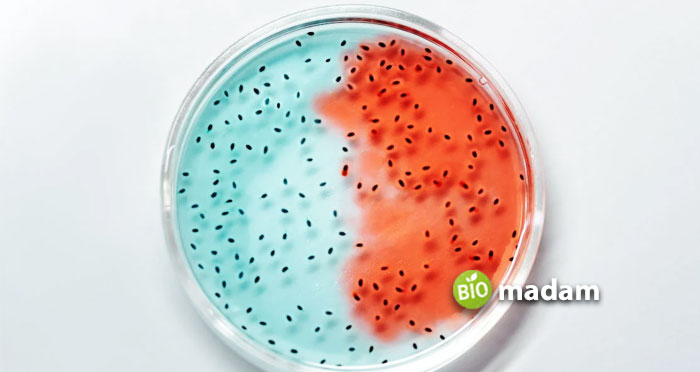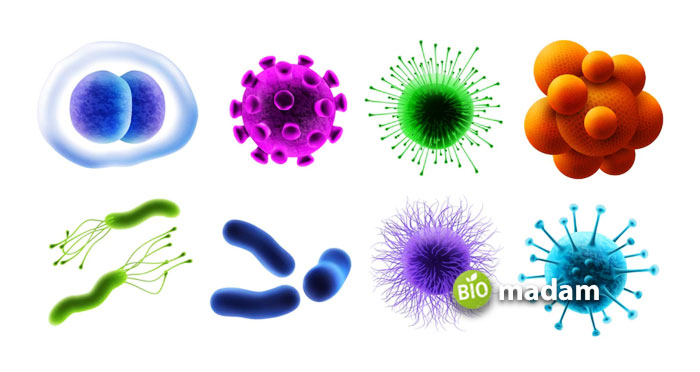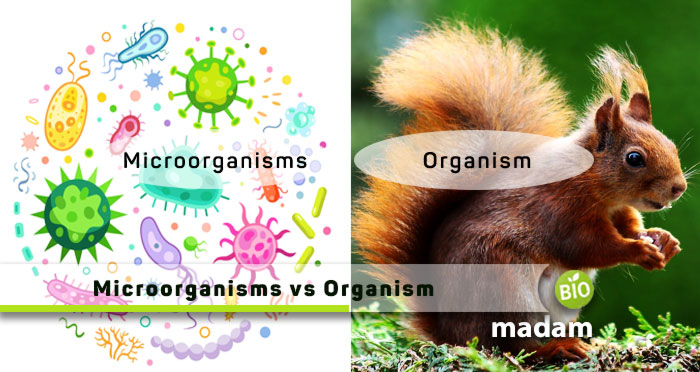Organisms and microorganisms are essential parts of the ecosystem, contributing to the significance of biodiversity. Studying their anatomy and physiology helps us understand ecosystems and communities better. They have specific functions in the food web and food chain depending on their organizational level that we will discuss further in the article. Though all organisms are composed of cells, tissues, and organs, some characteristics differentiate microbes. Organisms are easily visible, whereas you cannot see microorganisms without an electron or compound microscope.
Let’s tell you about the differences between organisms and microorganisms in detail.
Comparison Table
| Factors | Organism | Microorganism |
| Visibility | Naked eye | Microscope |
| Organization | Complex | Simple |
| Cellular Level | Multicellular | Unicellular |
| Growth | Mitosis | Cytoplasm |
| Reproduction | Sexual | Asexual |
What is an Organism?
Merriam-Webster defines an organism as “an individual constituted to carry on the activities of life through parts or organs more or less separate in function but mutually dependent.” These organisms are generally referred to as multicellular organisms. They are larger and can be easily seen without a microscope.
Examples of organisms include humans, plants, reptiles, amphibians, insects, etc.

Characteristics of Organisms
Multicellular organisms are highly complex living things with a complicated structure comprising different functions. They grow by cell division and reproduce sexually. Here are some of their characteristics.
Complex Organization
They are highly organized, constituting several cells, tissues, organs, and organ systems. The cells and tissues (connective, epithelial, etc.) in each organ and organ system exhibit a particular function.
Body Functions
The body functions in multicellular organisms are highly specialized because of their complex body structure. The digestive, circulatory, and reproductive systems perform specialized processes with the help of neurotransmitters, hormones, enzymes, and other catalysts.
Growth
Their growth pattern is different from microorganisms. The cells multiply through mitosis and meiosis. Mitosis helps generate new growth cells whereas meiosis is essential for reproduction. Plants grow indefinitely under favorable conditions without a determined maturity age. On the other hand, animals grow to a definite height and shape before the cells degenerate.

Structure of Multicellular Organisms
Multicellular organisms have a proper organization system comprising organs and tissues made of cells. These organs further make up the organ systems performing functions. Almost all of them have the following body systems in one way or the other. They might be different from each other in looks but perform similar functions.
- Digestive system
- Lymphatic system
- Urinary system
- Breathing system
- Reproductive system
Classification of Organisms
The five kingdom classification system divides all organisms into five major kingdoms; Animalia, Plantae, Fungi, Protista, and Monera. Monera and Protista consist of unicellular prokaryotic and eukaryotic microscopic entities, whereas plants, animals, and fungi (most) are multicellular eukaryotes.
Fungi
- Fungi are typically heterotrophic decomposers
- Fungi are non-vascular with a chitin cell wall
- They reproduce through spores with the help of fungal nuclei.
Plants
- Plants are chlorophyll-containing autotrophs
- They are the producers in the food chain
- Plant cells have cellulose cell walls
Animals
- Animals are heterotrophic organisms
- They can move from one place to another independently
- They reproduce sexually
What is a Microorganism?
Microorganisms are defined as “organisms of microscopic or ultramicroscopic size.”
Microorganisms are also organisms as they are composed of a cell (or cells). However, they are not typically visible to the naked eye. You need a digital, compound, or electron microscope to see a microorganism. They are often disease-causing pathogens or antigens.
Examples of microorganisms are molds, fungi, protozoans, bacteria and viruses.
One important thing to remember here is that all microorganisms are organisms, but all organisms are not microorganisms.
Characteristics of Microorganisms
Microorganisms and organisms are different from each other in various aspects. Microbes are typically acellular, unicellular or multicellular. They are visible only under a microscope. They do not have specialized functions and do not reproduce through meiosis. Most microbes, including bacteria and yeast, reproduce asexually through binary fission and budding. Features of microorganisms include the following:

Morphology
The morphology of microorganisms is only visible under a microbiology or student microscope. They have several organelles such as flagella, cilia, and pili in most prokaryotes.
Growth
They do not increase in size through cell division. Instead, their growth is attributed to an ordered increase in the cytoplasm size.
Nutrition and Environment
Microorganisms do not have the same kind of nutritional requirements as multicellular. Some species use organic compounds from the environment, while others utilize oxygen to perform photosynthesis and cellular respiration. Some of the microbes also metabolize organic compounds like hydrocarbons. On the other hand, many species use lipids, carbohydrates, and proteins. Microscope fungi rely on nutrition from dead matter and are known as decomposers. Bacteria, fungi, and viruses exhibit parasitic behavior.
Reproduction and Growth
Bacteria and other microbes divide asexually by binary fission or fragmentation. It is a simple process in which the cell divides into two without fertilization. Most cells reproduce through binary fission every fifteen minutes. Viruses use the host cell to multiply as they cannot self-reproduce. Bacteria, protozoans, and other parasites require a suitable medium to grow.
Classification of Microorganisms
Kingdom Monera and Protista comprise the majority of microbes besides some microscopic fungi. There is no further taxonomic classification of microorganisms as such. However, they can be divided into seven major groups.
- Algae: Mostly single-celled, aquatic, non-flowering entity with chlorophyll a and b
- Protozoa: Groups of single-celled free-living or parasitic eukaryotes that feed on organic matter
- Slime molds: Organisms with an acellular creeping gelatinous protoplasm mass that form spore cases on growth
- Fungi: Spore-producing, heterotrophic organisms feeding on dead matter
- Bacteria: Unicellular disease-causing (some) microorganisms with cell walls without a proper nucleus
- Archaea: Archaea and eubacteria differ in molecular organization with a similar structure
- Viruses: Disease-causing micro parasites that need a host to grow and reproduce

Difference between Microorganisms and Organisms
Definition
Organism
An individual constituted to carry on the activities of life comprising organs and organ systems separate in function but mutually dependent is known as an organism.
Microorganism
On the other hand, microorganisms are living organisms of microscopic or ultramicroscopic size.
Visibility
Organism
They are visible to the naked eye.
Microorganism
On the other hand, you can see microbes only with a suitable microscope.
Organization
Organism
Organisms have a complex organization level comprising cells, tissues, organs, and organ systems.
Microorganism
Contrarily, microorganisms typically comprise a simple structure without double-layered organelles.
Cellular Level
Organism
They can be unicellular or multicellular. Animals, plants, and fungi are multicellular eukaryotic organisms.
Microorganism
Transversely, microorganisms are typically unicellular.
Growth and Development
Organism
Organisms grow and develop through cell division (mitosis).
Microorganism
Alternatively, microorganisms, like bacteria, do not grow by cell division. Instead, their cytoplasm increases after a particular size.
Reproduction
Organism
They reproduce sexually, primarily through meiosis.
Microorganism
Whereas microorganisms reproduce through asexual reproductive methods like binary fission, budding, spore formation, etc.
The Bottom Line
Different types of biodiversity in an ecosystem depends on all living beings From unicellular microbes like bacteria, algae and fungi to multicellular eukaryotic plants and animals, all are essential to the environment. The most significant difference between microorganisms and organisms is the inability to see microorganisms without a microscope. Organisms divide and grow through meiosis, whereas microbes increase cytoplasm in size. Organisms and microorganisms reproduce sexually and asexually, respectively. They perform specific functions and are essential to the ecosystem.
FAQs
How are microorganisms different from other living organisms example?
Microorganisms are invisible to the naked eye and visible only under the microscope. Microbes, like viruses, possess characteristics of non-living and living.
Is there any difference between microorganisms and microbes?
Microbes and microorganisms are tiny organisms present all around us. They are two terms for the same kind of entities.
What is the difference between microorganisms and macro organisms?
Microorganisms refer to living things seen under a microscope. Alternatively, you can easily see macroorganisms with the naked eye or observe them under a stereo microscope.

Jeannie has achieved her Master’s degree in science and technology and is further pursuing a Ph.D. She desires to provide you the validated knowledge about science, technology, and the environment through writing articles.

